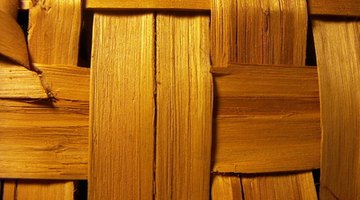How to Make Grapevine Furniture
If you live near a vineyard, the proprietors will sometimes allow you to cart away their discarded grapevines. Alternatively, you can cut wild grapevines or buy dried grapevines at a craft store. Construct weight-bearing grapevine furniture by weaving the vines over a frame, or use the twisted older vines as a furniture base. You can refurbish wicker furniture, use a ready-made frame or make one yourself. Many materials work as frames; bamboo is easy to work with, durable and readily available. Begin with a simple project such as an end table, which is suitable for a first-time project.
Frame

Step 1

To make a 20-inch square end table, begin with 2-inch diameter bamboo for the frame. Cut eight sections of 20-inch bamboo, 20 inches long, for a square-topped end table.
Step 2
Assemble the tabletop first. Fasten together four 20-inch sections of bamboo using screws.
Step 3
Shape the tops of the legs so the straight legs fit easily against the top frame and form a square. Using a craft knife or hand saw, cut away a portion of the top of the legs to fit against the curve of the frame. Attach the legs to the corners of the tabletop frame using screws. Avoid drilling through the nodes, the raised rings that occur naturally in bamboo. Insert the screws from the outside of the tabletop frame legs into the frame and one from the inside of the leg out into the frame; tighten screws. Vary the exact placement of the screws, depending on the natural features of the bamboo.
Weaving the Grapevine
Step 1
Soak the grapevine at least 24 hours or overnight to make it more pliable and easier to work with. Wash the soaked vine to remove any loose materials.
Step 2

Weave the vine over and under in a crosshatch pattern, alternating horizontal and vertical vines as you work. Start at the center of the table. Tuck the ends into the weave as you work. If the vine end is stiff, secure the end from the underside with florist wire so that it does not unravel.
Step 3

Work the vine, alternating down the legs and up to the tabletop edge, at an angle, working toward the center of the tabletop, to help stabilize the table construction. Bring the weave down approximately 3 or 4 inches; bringing it all the way down is unnecessary. Complete all four legs vertically before adding the horizontal weave; then take the horizontal weave all the way around. This section of weave adds stability, but not strength, to the construction. Play with patterns and perfect your technique for the next project.
References
Writer Bio
Virginia Grant wrote her first cookbook "Wholly Crepe" in 2008 and has since added "Easy Roasts," "A Deep Beauty," "Breaking Up The Big Banks" (with T.J. Walker) and an ACC "Guide to Long Island Sound." She has been a business analyst, law librarian and paralegal, and real estate broker.
Photo Credits
- Wild Grapevine image by Empath from Fotolia.com
- bamboo image by fotografiche.eu from Fotolia.com
- basket weave image by robert mobley from Fotolia.com
- Wild grape leaf and grapevine image by Doodlebugs from Fotolia.com
More Articles



